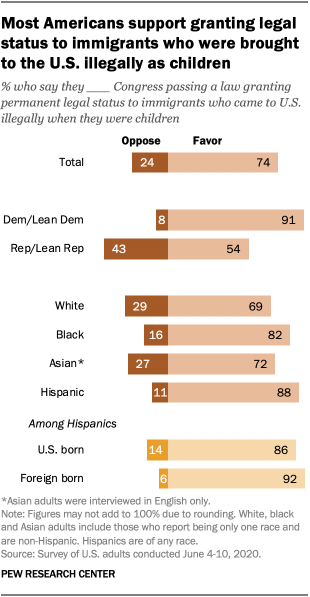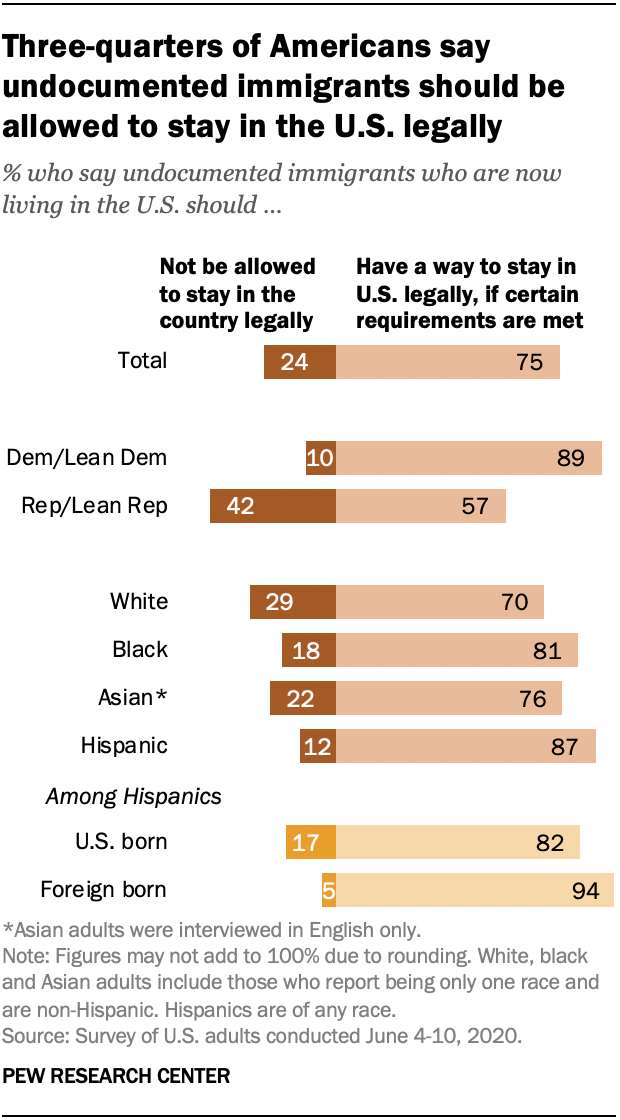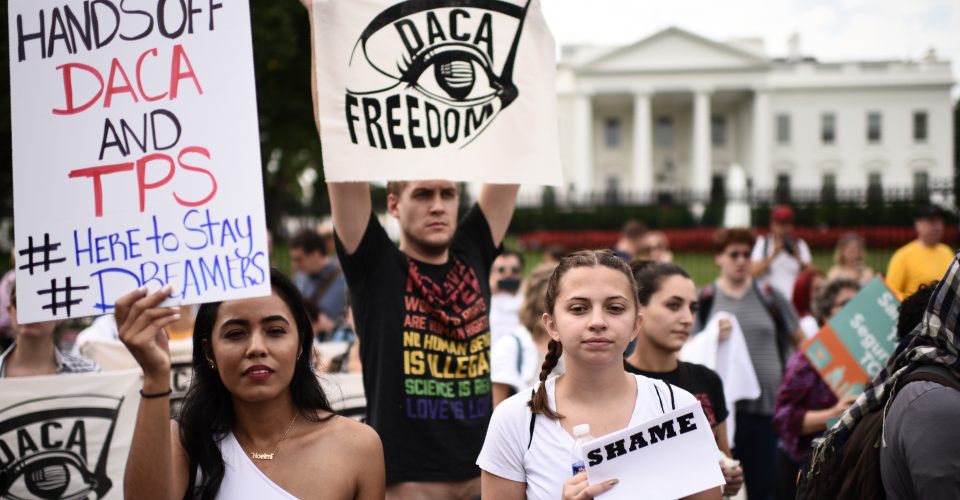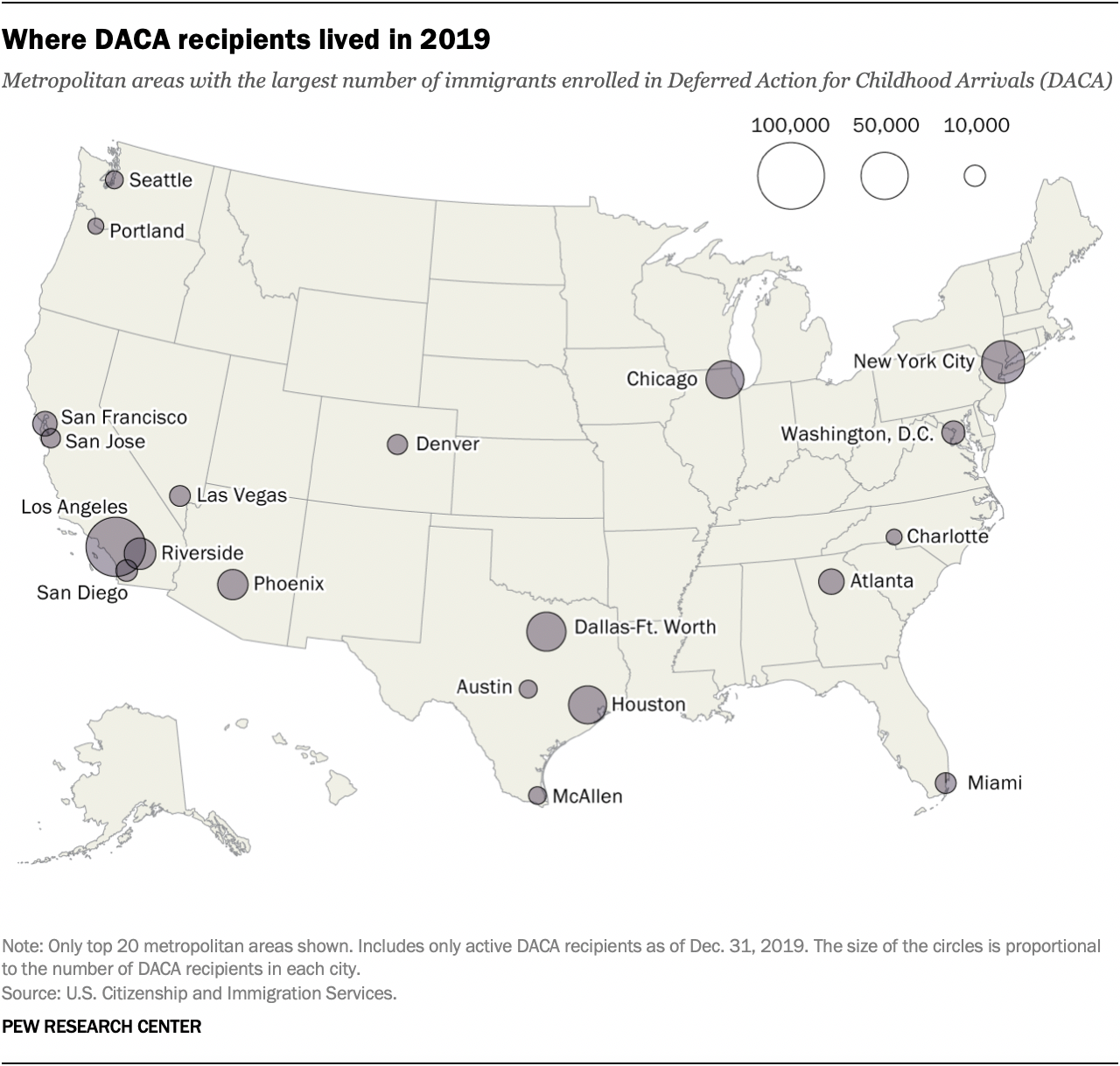About three-quarters of U.S. adults say they favor granting permanent legal status to immigrants who came illegally to the United States when they were children, with the strongest support coming from Democrats and Hispanics, according to a Pew Research Center survey conducted June 4-10, 2020.
As the U.S. Supreme Court weighs the future of the Deferred Action for Childhood Arrivals program (or DACA), 74% of Americans favor a law that would provide permanent legal status to immigrants who came to the U.S. illegally as children, while 24% are opposed. As with other immigration issues, some of the sharpest differences in these views are between Democrats and Republicans. While 91% of Democrats and Democratic-leaning independents favor granting legal status to immigrants who came to the U.S. illegally as children, about half of Republicans and Republican leaners (54%) say the same.
Support also varies by race and ethnicity. About nine-in-ten Hispanics (88%) say they favor granting legal status to immigrants who came to the U.S. illegally as children, with similar shares of U.S.-born and immigrant Hispanics saying so. Smaller majorities of black (82%), Asian American (72%) and white (69%) adults say the same.
A closer look at DACA enrollees
As of the end of 2019, about 649,000 immigrants have work permits and protection from deportation under DACA. To qualify for the program, enrollees must have met a variety of conditions, such as entering the U.S. before their 16th birthday and not being convicted of certain crimes.
Nearly all DACA recipients (about 96%) were born in the Latin America and Caribbean region, according to an analysis of data from the Department of Homeland Security. Mexico (521,440) was by far the top birth country, followed by El Salvador (25,050), Guatemala (16,970) and Honduras (15,570). After Latin America and the Caribbean, the next-largest share of DACA enrollees came from Asia (3%). The top Asian countries of origin included South Korea (6,280), Philippines (3,320) and India (2,290).
DACA enrollees, a group sometimes called “Dreamers,” are dispersed across all 50 states and the District of Columbia, but just six states account for more than half of the total: California (184,880), Texas (107,020), Illinois (34,150), New York (28,560), Florida (25,090) and North Carolina (24,230).
About six-in-ten DACA enrollees live in just 20 U.S. metropolitan areas. The Los Angeles-Long Beach-Anaheim area (80,540) has the most DACA recipients, nearly twice as many as in the New York-Newark-Jersey City metro area (41,800). The next largest metro areas for DACA recipients are Dallas-Fort Worth-Arlington (34,980), Houston-The Woodlands-Sugar Land (32,790) and Chicago-Naperville-Elgin (32,550).
Demographically, women slightly outnumber men among DACA recipients (53% vs. 47%). Meanwhile, the average age of a DACA recipient is 26; about two-thirds of enrollees (67%) are between the ages of 21 and 30.
Most Americans favor a pathway to legal status for all undocumented immigrants
In the Center’s new survey, Americans also express support for finding a way for all undocumented immigrants – not just those brought to the country as children – to stay in the U.S. legally.
 Overall, three-quarters of adults say there should be a way for undocumented immigrants living in the U.S. to stay in the country legally if certain conditions are met. Majorities in both party coalitions express support, but Democrats are again much more likely than Republicans to do so (89% vs. 57%). These views are little changed from August 2019.
Overall, three-quarters of adults say there should be a way for undocumented immigrants living in the U.S. to stay in the country legally if certain conditions are met. Majorities in both party coalitions express support, but Democrats are again much more likely than Republicans to do so (89% vs. 57%). These views are little changed from August 2019.
Among Hispanics, more immigrants (94%) than the U.S. born (82%) support allowing undocumented immigrants to stay in the U.S. legally. Majorities of black (81%), Asian (76%) and white adults (70%) also express support.
The number of undocumented, or unauthorized, immigrants living in the U.S. stood at 10.5 million in 2017, down from a peak of 12.2 million in 2007, according to Pew Research Center estimates. Just under half of the nation’s unauthorized immigrants are from Mexico.
Note: Here are the questions asked for this report, along with responses, and its methodology.











